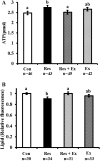Modification of mitochondrial function, cytoplasmic lipid content and cryosensitivity of bovine embryos by resveratrol
- PMID: 28603221
- PMCID: PMC5649094
- DOI: 10.1262/jrd.2016-182
Modification of mitochondrial function, cytoplasmic lipid content and cryosensitivity of bovine embryos by resveratrol
Abstract
Resveratrol is a potent activator of NAD-dependent deacetyltransferase sirtuin-1 (SIRT1) and affects lipid metabolism and ATP generation in somatic cells. In the present study, the effects of supplementing culture medium with resveratrol on lipid metabolism, ATP generation, and cryosensitivity of bovine in vitro produced embryos were investigated. Bovine early cleaved-stage embryos were cultured in medium containing 0 or 0.5 µM resveratrol for 1 or 5 days. Resveratrol treatment for both 1 day and 5 days increased the expression levels of SIRT1 and phosphorylated AMP-activated protein kinase (pAMPK) in the embryos. Furthermore, resveratrol treatment was effective to increase ATP generation and reduce lipid content of the embryos. The effects of resveratrol treatment were diminished by the SIRT1 inhibitor "EX527", and the reduced lipid content was reversed by treatment with etomoxir (a potent inhibitor of beta-oxidation). Blastocysts developed after resveratrol treatment showed low levels reactive oxygen species and increased cryotolerance. These results demonstrate that resveratrol improves in vitro development of bovine embryos, while reducing cytoplasmic lipid content through activation of beta-oxidation, thereby effective for production of bovine blastocysts with enhanced cryotolerance.
Keywords: Cryopreservation; Embryos; Lipid; Mitochondria; Resveratrol.
Figures




References
-
- Holm P, Callesen H. In vivo versus in vitro produced bovine ova: similarities and differences relevant for practical application. Reprod Nutr Dev 1998; 38: 579–594. - PubMed
-
- Khurana NK, Niemann H. Energy metabolism in preimplantation bovine embryos derived in vitro or in vivo. Biol Reprod 2000; 62: 847–856. - PubMed
-
- Sturmey RG, Bermejo-Alvarez P, Gutierrez-Adan A, Rizos D, Leese HJ, Lonergan P. Amino acid metabolism of bovine blastocysts: a biomarker of sex and viability. Mol Reprod Dev 2010; 77: 285–296. - PubMed
-
- Abe H, Hoshi H. Evaluation of bovine embryos produced in high performance serum-free media. J Reprod Dev 2003; 49: 193–202. - PubMed
-
- Fukui Y, Kikuchi Y, Kondo H, Mizushima S. Fertilizability and developmental capacity of individually cultured bovine oocytes. Theriogenology 2000; 53: 1553–1565. - PubMed
MeSH terms
Substances
LinkOut - more resources
Full Text Sources
Other Literature Sources

